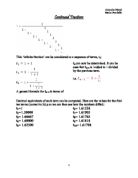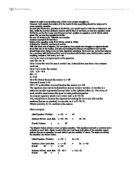Fraction Differences
First Sequence
To begin with I looked at the first sequence of fractions to discover the formula that explained it. As all the numerators were 1 I looked at the denominators. As these all increased by 1 every time, I figured that the formula was simply as the denominators corresponded to the implied first line as shown in this table below:
nth number
2
3
4
5
6
7
8
Denominators
2
3
4
5
6
7
8
I shall call this Formula 1 (F1) for easy reference.
Second Sequence
Again I decided to discount the numerator as it was 1, and I decided to concentrate on the differences between the denominators rather than the 'fractions'. So I am looking for a formula that will explain the sequence: 2, 6, 12, 20, 30.
First of all though I decided to extend the sequence in order to have a broader range to work with. I used a calculator to work out the following denominators finding the difference between and , and all the way up to
I set the differences out in a table to try to find the pattern:
nth number
2
3
4
5
6
7
8
9
Sequence
2
6
2
20
30
42
56
72
90
First Difference
4
6
8
0
2
4
6
8
Second Difference
2
2
2
2
2
2
2
2
As there was a constant difference of 2 I believed that the formula would include n². I applied this to the first number in the sequence '2'. So n² = (1 x 1 = 1). To get the first number of the sequence - 2 I would have to add 1. Therefore the formula could be: n2 + 1
I tried this formula for the second number in the series. 22 = 2 x 2 = 4 + 1 = 5.
First Sequence
To begin with I looked at the first sequence of fractions to discover the formula that explained it. As all the numerators were 1 I looked at the denominators. As these all increased by 1 every time, I figured that the formula was simply as the denominators corresponded to the implied first line as shown in this table below:
nth number
2
3
4
5
6
7
8
Denominators
2
3
4
5
6
7
8
I shall call this Formula 1 (F1) for easy reference.
Second Sequence
Again I decided to discount the numerator as it was 1, and I decided to concentrate on the differences between the denominators rather than the 'fractions'. So I am looking for a formula that will explain the sequence: 2, 6, 12, 20, 30.
First of all though I decided to extend the sequence in order to have a broader range to work with. I used a calculator to work out the following denominators finding the difference between and , and all the way up to
I set the differences out in a table to try to find the pattern:
nth number
2
3
4
5
6
7
8
9
Sequence
2
6
2
20
30
42
56
72
90
First Difference
4
6
8
0
2
4
6
8
Second Difference
2
2
2
2
2
2
2
2
As there was a constant difference of 2 I believed that the formula would include n². I applied this to the first number in the sequence '2'. So n² = (1 x 1 = 1). To get the first number of the sequence - 2 I would have to add 1. Therefore the formula could be: n2 + 1
I tried this formula for the second number in the series. 22 = 2 x 2 = 4 + 1 = 5.







